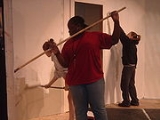
Scenic painting
Encyclopedia

Painting
Painting is the practice of applying paint, pigment, color or other medium to a surface . The application of the medium is commonly applied to the base with a brush but other objects can be used. In art, the term painting describes both the act and the result of the action. However, painting is...
and craft techniques. An experienced scenic painter will have skills in landscape
Landscape art
Landscape art is a term that covers the depiction of natural scenery such as mountains, valleys, trees, rivers, and forests, and especially art where the main subject is a wide view, with its elements arranged into a coherent composition. In other works landscape backgrounds for figures can still...
painting, figurative painting, trompe l'oeil
Trompe l'oeil
Trompe-l'œil, which can also be spelled without the hyphen in English as trompe l'oeil, is an art technique involving extremely realistic imagery in order to create the optical illusion that the depicted objects appear in three dimensions.-History in painting:Although the phrase has its origin in...
, and faux finishing, be versatile in different media such as acrylic
Acrylic paint
Acrylic paint is fast drying paint containing pigment suspension in acrylic polymer emulsion. Acrylic paints can be diluted with water, but become water-resistant when dry...
, oil
Oil painting
Oil painting is the process of painting with pigments that are bound with a medium of drying oil—especially in early modern Europe, linseed oil. Often an oil such as linseed was boiled with a resin such as pine resin or even frankincense; these were called 'varnishes' and were prized for their body...
, and tempera
Tempera
Tempera, also known as egg tempera, is a permanent fast-drying painting medium consisting of colored pigment mixed with a water-soluble binder medium . Tempera also refers to the paintings done in this medium. Tempera paintings are very long lasting, and examples from the 1st centuries AD still exist...
paint, and be an accomplished gilder
Gilding
The term gilding covers a number of decorative techniques for applying fine gold leaf or powder to solid surfaces such as wood, stone, or metal to give a thin coating of gold. A gilded object is described as "gilt"...
, plasterer, and sculptor
Sculpture
Sculpture is three-dimensional artwork created by shaping or combining hard materials—typically stone such as marble—or metal, glass, or wood. Softer materials can also be used, such as clay, textiles, plastics, polymers and softer metals...
. The techniques and specialized knowledge of the scenic painter in replicating an image to a large scale are largely different from those of the traditional studio artist. . In addition he is often expected to make the finished product fire-proof
Fireproofing
Fireproofing, a passive fire protection measure, refers to the act of making materials or structures more resistant to fire, or to those materials themselves, or the act of applying such materials. Applying a certification listed fireproofing system to certain structures allows these to have a...
, and to work quickly within a tight budget.
Traditionally, scenic painters are drawn from the ranks of scenic designers, and in some cases designers paint their own works. Increasingly scenic painting is looked upon as a separate craft, and scenic painters are expected to subordinate their skills to those of the designer. A designer submits scaled paintings, maquette
Maquette
A maquette is a small scale model or rough draft of an unfinished architectural work or a sculpture...
s or photographs, perhaps with original research, and sometimes accompanied by paint samples; the painter is expected to paint scenery to match.

